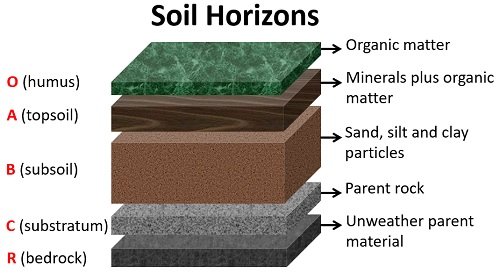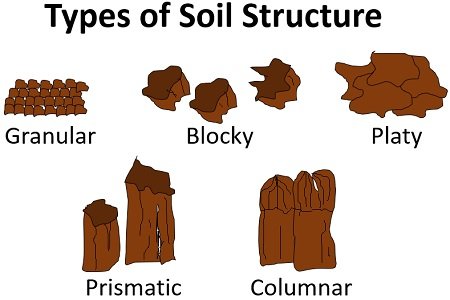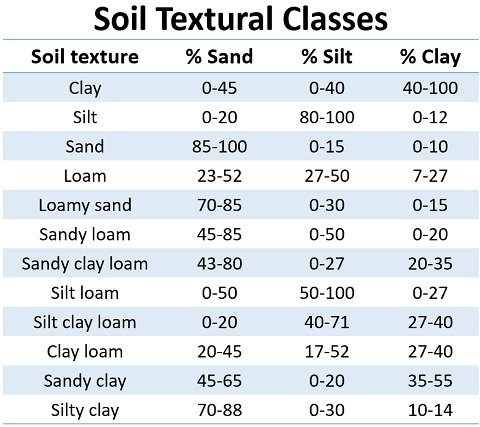Soil structure and texture are the physical properties that influence soil retention, drainage system, and aeration capabilities. It also defines the movement of air, water and ions within the soil, which affects other factors like seed germination, root growth, and erosion processes.
Soil structure gives an idea about the arrangement of the soil particles that form aggregates (or peds) and acquire some distinct shapes. Pore spaces are also found in the soil structure. Soil texture gives a relative proportion of the soil particles like sand (coarse and fine), silt and clay.
Soil structure and texture helps in the soil classification and description. In this context, we will discuss the definition, types and importance of the soil structure and texture.
Content: Soil Structure and Texture
- Soil Horizonation
- Soil Structure Definition
- Types of Soil Structure
- Pore Spaces
- Soil Texture Definition
- Types of Soil Texture
- Importance
- Conclusion
Soil Horizonation
It refers to the process of soil formation that is separated by the six distinct layers or horizons. Let us look into the diagram given below and understand each layer of soil in detail.

- Horizon-O (Humus or Organic): It appears as a thin layer, mainly comprised of dead organic matter (predominantly decomposed leaves).
- Horizon-A (Topsoil): It primarily has a combination of plant’s organic material and minerals.
- Horizon-E (Eluviated): Only older or forest soils have eluviated layer and contain perlocated clay, inorganic minerals and organic matter.
- Horizon-B (Subsoil): It is rich in minerals and containing a residual concentration of sesquioxides.
- Horizon-C (Substratum): It serves as the parent material that contains weathered mineral nutrients. Horizon-C forms the overlying soil horizons.
- Horizon-R (Bedrock): It provides the unweathered parent material, which contains granite, basalt, quartz, and limestone etc. Horizon-R is present underneath the substratum.
Soil Structure Definition
It refers to the aggregation of the soil components (sand, silt and clay) with the larger units (organic matter, iron oxides, carbonates etc.). Thus, the aggregated soil particles contribute to the soil structure, which is called the ped. Soil structure is influenced by soil moisture, microbial flora, organic matter and root growth.
Types of Soil Structure
Soil structure is generally classified based on the following factors:
Based on the Ped Structure and Arrangement

Granular
- Appears roughly spherical
- Diameter- 1-10 mm
- Common in horizon-A
Platy
- Appears flat peds
- Soil particles lie horizontally.
- Common in horizon-A (also in horizon-B and C)
Blocky
- Appears roughly cube-shaped
- Size- 5-50 mm
- Common in horizon-B
- Form via expansion and contraction of clay-minerals
Prismatic
- Appears vertically elongated
- Size- 10-100 mm
- Occurs in fragipans
Columnar
- It appears as prismatic peds.
- Vertically elongated
- Rounded tops
- Common in horizon-B
Based on the Ped Size
- Very fine or very thin: Size ranges between <1 mm to <10 mm.
- Fine or thin: Size ranges between 1–2 mm to 10–20 mm.
- Medium: Size ranges between 2–5 mm to 20–50 mm.
- Coarse or thick: Size ranges between 5–10 mm to 50–100 mm.
- Very coarse or very thick: Size ranges between >10 mm to >100 mm.
Based on Grades
It defines the soil strength and integrity by the property of aggregation or cementation within the peds.
- Structure less or massive soil: Peds are not distinct (exist as a cemented mass). It comprises heavy clays that contribute to compact and coherent soil. It has poor aeration and soil permeability. Strong grade soil particles are pretty durable and distinct.
- Weak or single grained soil: Peds contain silt and sand that makes the soil highly erodable. It lacks cementing agents and has low soil fertility and water-holding capacity.
- Moderate or aggregated soil: Peds are distinct and considered an ideal soil structure.
Aggregated soil also possesses pores. Large pores or macropores allow good aeration, water and mineral retention, as well as support microflora growth.
Small pores or micropores reduces the water and mineral retention capacity. The soil is typically classified into two types, depending upon the pore size of the soil particles.

- Well-structured soil
- Soil aggregates or peds are stable
- Possess variable pore-size
- Soil is friable
- Promotes strong root system and facilitates rapid water movement
- Poorly-structured soil
- Soil aggregates or peds are unstable
- Possess few pore spaces
- Soil is slaked and easily erodable
- It exists as waterlogged soil with poor drainage and aeration system
Pore Spaces
Pore spaces refer to the spaces between the soil aggregates. Water and air occupy the pore spaces. Water content is inversely proportional to air content. Soil porosity is determined by the size and arrangement of the soil particles.
- Macropores or non-capillary pore spaces allow rapid water movement.
- Micropores or capillary pore spaces allow slow water movement.
Soil possess interstitial spaces. It increases with an increase in organic matter and decreases with the decrease in pore spaces and soil depth. Soil porosity promotes plant growth, as it entraps requires water, air and minerals.
Soil porosity represents the percentage of the soil volume. We could determine the soil porosity if the values of particle density and bulk density are known. The average soil density is 2.65 grams per cubic centimetre. Soil density varies in different types of soil.
Particle density
It refers to the solid portion of the soil. It is expressed by the equation, which is equal to the sum of the average density of organic and inorganic particles within the soil. The average particle density of the organic soil and inorganic soil is 1.2-1.7 g/ml and 2.6-2.78 g/ml, respectively.
Particle Density= Weight of solids/Volume of solids
By knowing the particle density, we could calculate the specific gravity of soil particles by the given equation:
Specific Gravity= Particle density/Water density
Bulk or apparent density
It is represented by dry soil mass by the soil volume. Air spaces and organic materials contribute to the soil volume. It is highly variable. Bulk density is inversely proportional to the soil porosity, which means high bulk density reduces soil compaction or soil porosity. Its value is less than the particle density. The average bulk density of soil is 15 g/ml.
Thus, soil porosity can be calculated by the given formula:
% Solid space= (Bulk density/Particle density) X 100
% Porosity= 100 – (% Solid space)
Soil Texture Definition
It refers to the soil proportion, which separates the three significant components like sand, silt and clay. Their relative proportion and size differ in soil. Soil texture is also a property through which we could classify the soil type.
Types of Soil Texture
Sand and silt hold quartz and other inactive minerals or considered “Inactive part” of the soil horizons. Oppositely, clay is considered an “Active-part” of the soil matrix, as it provides active absorption of water and ions due to its small particle size and large surface area.
Sand and silt are formed by weathering of the parent rock. Clay is formed through the precipitation of the dissolved parent rock. Soil texture also influences soil porosity, permeability and water-nutrients holding capacity.
Intrinsic Properties
Sand
- Nature: Gritty
- Role: It resists soil compaction and increases soil porosity
- Pore size: <2-0.05 mm
- Specific surface area to retain water and nutrients: Low
Silt
- Nature: Silky and smooth
- Role: It promotes water retention and air circulation
- Pore size: 0.05-0.002 mm
- Specific surface area to retain water and nutrients: Comparatively higher than the sand particles
Clay
- Nature: Sticky
- Role: It increases water retention, resists wind and water erosion due to its sticky behaviour
- Pore size: <0.002 mm
- Specific surface area to retain water and nutrients: Large
The specific surface area increases exponentially, starting from the sand to clay, which increases the soil’s adsorption phenomena along with the other properties like soil plasticity and swelling.
Sand, silt and clay colloquially form a fine earth fraction. They primarily contain inorganic and organic compounds (lack minerals).
- Inorganic soil: It has a particle size 2 mm or larger and called rock fragments.
- Organic materials: It contains 20-30% organic matter (peak, muck and mucky peat).
Based on the percentage of the textural components, there are 12 textural classes of soil.

Importance of Soil Texture and Soil Structure
We could determine the pore size and the specific surface area of the textural components (sand, silt and clay). Small particles provide more surface area for the water and nutrient absorption by the soil, which supports plants growth and provides a favourable atmosphere for the soil microflora.
Large surface area between the soil particles facilitates more weathering of minerals, organic and inorganic materials and decides the soil colour. Soil exhibits different colour.
- Organic matter: It imparts a dark black, brown or grey colour.
- Inorganic materials: Iron oxides generally give a red, brown or yellow colour to the soil particles. Oppositely, silica and lime impart light white or grey-tinges to the soil.
A large surface area between the particles also aids in ions movement into the soil, which helps soil aggregation or binding of soil particles. We could determine the soil consistency by knowing the moisture content in the soil structure.
- Moist Soil
- Loose and noncoherent
- Friable
- Firm
- Wet Soil
- Readily deformed
- Sticky
- Dry Soil
- Individual grains
- Hard
Conclusion
Soil physical properties like soil structure and texture perform a significant role in regulating plant growth responses, by providing water and ions required for the plant cellular activities. Besides that, soil structure and texture also have a control over the other properties like water runoff, water retention, nutrient loss and soil erosion properties. Inorganic particles, organic matter, pore spaces and the soil microflorae make up the mineral-based soil.